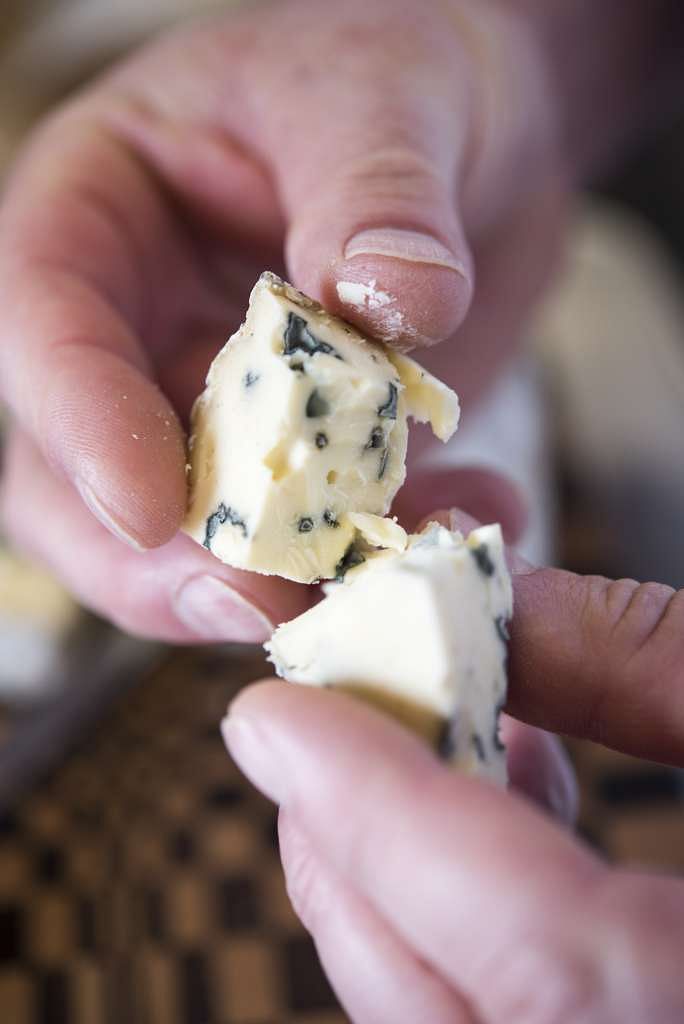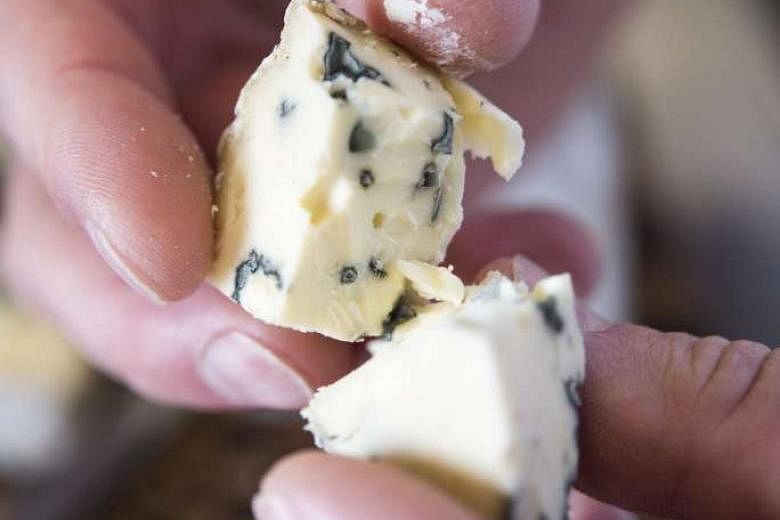GREENSBORO, VERMONT (NYTIMES) - There is no sign announcing that you have arrived at Jasper Hill Farm, a creamery in the Northeast Kingdom, as Vermonters call that end of their state, but you can't miss it. The main barn is painted midnight blue with a giant cheese moon and cows floating happily in space. Blasted into the hillside is a concrete bunker with seven cheese caves radiating from a central core.
There is one other surprising detail: A modern two-room laboratory filled with microbiology equipment and staffed with scientists.
Why does a small rural creamery invest in technology for what has long been a low-tech product? Because it does not have 500 years to learn what its European counterparts already know: The biological intricacies of how to make the best cheese in a particular place. And because the same diversity of microbial cultures is not available in North America.
"Building a lab might seem extravagant or of questionable value, but what we get as a business over two, three, four generations - it's a no-brainer," said Mr Mateo Kehler, who owns the farm with his brother, Andy.
The making of cheese depends on the contribution of myriad microbial actors. Both yeast and bacteria are components of the starter cultures that help turn milk into solids, and those solids into cheeses with distinctive aromas, flavours and textures. The interplay of these species, while understood in a basic sense, is now receiving renewed scientific scrutiny and appreciation in the United States.
Unlike their peers in Europe, who benefit from centuries of tradition and from government support for research, U.S. farmstead cheesemakers have typically gone it alone. Starter cultures are a vexing ingredient. The only three domestic suppliers, including DuPont and Cargill, are multinational corporations better known for chemicals, which has limited the number of available cultures and caused discomfort in a field that strives for individuality.
But now several small cheese producers are working with scientists to develop their own starters and use microbiology to create better cheeses.
Murray's Cheese is working with Rockefeller University to learn more about the microflora in its cheese caves in Long Island City, Queens, New York. Uplands Cheese Co. is working with the Center for Dairy Research at the University of Wisconsin to create a new soft cheese, its first in seven years.
But perhaps none have taken on cheese science as rigorously as Jasper Hill. Its lab, opened in 2013, has become a hub for other cheesemakers seeking help and insight.

When the Kehler brothers began making cheese in 2003, their aim was to invigorate the local dairy industry, which was, and still is, struggling. They started on their path to applied science in 2010, when Dr Rachel Dutton, a Harvard scientist, decided to use cheese as a model to research how small microbial communities interact; she focused on the composition of cheese rinds.
Her first contact in the cheese business was Mr Mateo Kehler, who taught her to make cheese, then helped her reach out to more than 100 other producers for samples. The response was overwhelming. "I don't think she realised how excited the artisan cheese industry was going to be," Kehler said.
In 2014, Dr Dutton published her findings in the journal Cell. Working with Dr Benjamin Wolfe, a postdoctoral researcher, she reported that the environment (cows, cheese caves, pastures) and methods (washing, salting, managing acidity) were as important to the development of cheese rinds, if not more so, than the ingredients.
This was a revelation. The Kehlers stopped adding starter cultures to Winnimere, one of their most popular raw-milk cheeses. "What we were adding wasn't growing, and when we stopped adding that, the cheese ripened more gracefully and deliciously," Mr Mateo Kehler said.
Their pasteurised cheeses, though, still needed starters because pasteurisation kills bacteria both good and bad for cheese. So they began making starter cultures from bacteria in their own milk supply. Besides ending their reliance on big business, this has allowed the brothers to create a cheese that can come only from a singular place: Greensboro, Vermont.
In addition to having staff members who deeply understand microbiology, Jasper Hill Farm has become a magnet for researchers. Now working there are an engineering intern from Brittany, France; a local microbiologist; and Mr Panos C. Lekkas, a food microbiologist who has investigated the best ways to feed, tend and milk a cow for cheese production.
Mr Lekkas, who is helping improve food safety procedures at the 85-person Jasper Hill Farm, is also overseeing the development of a new cheese - a French Camembert style that for now the team is calling Wild Moses. He was told that it takes eight months to bring a new cheese to market.
"Mateo wants me to do it in three," he said. With science comes speed.

To make a soft pasteurised cheese that does not rely on corporate additives, the scientists sampled 300 promising strains of yeast and bacteria, all pulled from milk from Jasper Hill's own 250 cows.
What makes a homegrown starter promising? Sometimes it is the colour of the microbes in a petri dish, but smell, too, can be telling. The group sniffed the samples and noted any pleasing aromas: Play-Doh, Concord grapes, clams, Kraft American Singles.
Dr Wolfe's lab ran a full genomic sequencing on the 15 top contenders, which will provide a blueprint for understanding how these strains are related to, or differ from, other cultures in the cheese world.
Making funky cheese is tricky, even for scientists. "There are subtle variations in flavour and aroma that you perceive in cheese," Dr Wolfe said. "We want to understand what drives that variation."
With Dr Wolfe's genomic data, the team can track the microbes through the entire cheesemaking process.
In November, the first batch of cheese was produced using five strains from the original 15 parent cultures - two yeast-based and three bacterial. New batches are being made every two weeks using different combinations, and every 10 days, each will be tasted to see whether it is on target for the "deliciousness factor," Jasper Hill's zero-to-10 grading system.
Seven or above is pretty good. Eight is out of this world. Tens are likely to be bestowed only outside the farm: Jasper Hill's Harbison cheese recently took Super Gold at the World Cheese Awards in Spain.
"I will be happy with a seven," Mr Lekkas said.



